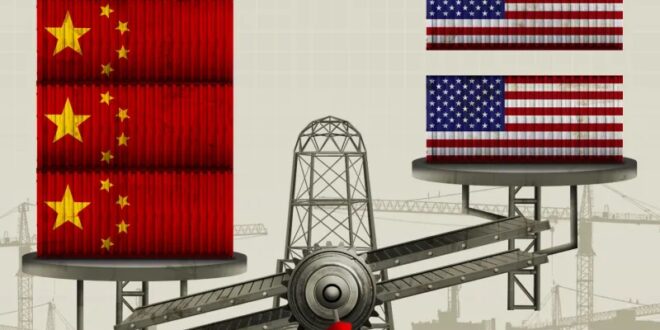America Should Once Again Become a Manufacturing Superpower
For many citizens, the American dream has been downsized. In recent decades, the United States has ceased to be the world’s workshop and become increasingly reliant on importing goods from abroad. Since 1998, the widening U.S. trade deficit has cost the country five million well-paying manufacturing jobs and led to the closure of nearly 70,000 factories. Small towns have been hollowed out and communities destroyed. Society has grown more unequal as wealth has been concentrated in major coastal cities and former industrial regions have been abandoned. As it has become harder for Americans without a college degree to reach the middle class, the withering of social mobility has stoked anger, resentment, and distrust. The loss of manufacturing has hurt not only the economy but also American democracy.
China has played a significant role in this deindustrialization of the United States. The explosion in job losses occurred after the U.S. Congress granted China the status of “permanent normal trade relations” in 2000, ahead of China’s accession to the World Trade Organization. Between 1985 and 2000, the U.S. trade deficit with China had grown steadily from $6 billion to $83 billion. But that deficit ballooned more dramatically after China joined the WTO in 2001, and it now stands at a stratospheric $309 billion. Once in the WTO, China unfairly undermined U.S.-based manufacturing by using exploited labor and providing sweeping state subsidies to Chinese firms. Even more than NAFTA—the 1994 free trade deal that allowed many U.S. manufacturing and farm jobs to move to Mexico—the liberalization of trade with China decimated factory and rural towns, particularly in the Midwest and in the South. This devastation fueled the rise of anti-immigrant xenophobia, anti-Asian hate, and right-wing nationalism that has threatened democracy at home through extremism and violence in U.S. politics.
It has become standard practice in U.S. foreign policy circles to rue American naiveté in believing that Beijing and Washington would benefit equally from China’s inclusion in the system of global trade. But that recognition has not always been accompanied by the requisite clarity and ambition in U.S. policymaking. The Biden administration has taken important steps in encouraging the return of jobs from overseas, supporting U.S. manufacturers, and seeking to deny China access to cutting-edge U.S. semiconductor technology. But the United States needs to enhance this agenda with specific place-based strategies to revitalize struggling parts of the country and strengthen partnerships between the public and private sectors.
Americans should embrace a new economic patriotism that calls for increasing domestic production, bringing jobs back from overseas, and promoting exports. An agenda focused on regional revitalization will offer hope to places that have endured decades of decline as policymakers watched haplessly and offered little more than Band-Aids to people laid off as a result of automation and outsourcing. A commitment to rebuild the U.S. industrial base does not mean the country should turn its back on the world and adopt the kind of insular economic nationalism that powered the 2016 Brexit vote in the United Kingdom. Instead, the United States can revive important industries while still preserving key trading relationships, welcoming immigrants, and encouraging the dynamism and innovation of its people.
Economic imperatives must drive U.S. foreign policy toward China, as much for domestic and global security as for national prosperity. Reducing the trade imbalance will lower tensions and mitigate the risk of populist anger or supply shocks inflaming conflicts between the geopolitical rivals. In every conversation with Beijing, Washington should focus on rebalancing production. U.S. policymakers should set annual targets for reducing the trade deficit with China. They can meet such goals through tough negotiations—for instance, regarding China’s artificially depreciated currency—and by unilateral policy adjustments, such as supporting manufacturers in the United States and in friendly countries. Such actions will help address the job losses, deindustrialization, and consequent opioid crises that have destabilized U.S. society. By realizing this vision, the United States will not just improve relations with China but further the goal of building a thriving, multiracial democracy that is an example to the world.
“WE STILL MAKE THINGS”
The trade deficit is an important proxy for the decline of the United States’ industrial base. In the first decade of this century, as MIT economist David Autor has shown, the United States lost 2.4 million jobs because labor-intensive industries moved to China. Beijing’s new trade status and low wages, along with its undervalued currency, incentivized U.S. companies to relocate manufacturing facilities there. Two decades later, the job loss count is up to 3.7 million, owing to the mushrooming trade deficit with China. The deficit reflects the decline in domestic industry: manufacturing accounted for 71 percent of the world’s trade in 2020, and nearly 73 percent of U.S. imports from China in 2019 were manufactured goods. Put bluntly, by running a trade deficit with Beijing, Washington creates jobs in China instead of in the United States.
Many economists and business owners do not regret the loss of manufacturing in the United States, arguing that the country’s economy has become more oriented around the service sector and producing knowledge and innovation. But innovation is intrinsically linked to production. Manufacturing companies account for more than half of U.S. domestic spending on research and development. And, as Intel chief Andrew Grove argued more than a decade ago, a key part of innovation is the “scaling” up that happens as new technologies move from prototype to mass production. That scaling happens less and less in the United States because so much manufacturing has shifted overseas. “Without scaling,” Grove lamented, “we don’t just lose jobs—we lose our hold on new technologies. Losing the ability to scale will ultimately damage our capacity to innovate.”
Manufacturing workers are also more likely to belong to unions, receiving protections that secure their membership in the American middle class; a solid industrial base and strong union participation expanded the middle class by leaps and bounds from the 1940s to the 1970s. The replacement of U.S. manufacturing jobs with service-sector jobs is, in truth, the erasure of reliable well-paying jobs in favor of more precarious low-paying ones.
Trade pacts are not suicide pacts.
Some argue that automation, more than the flight of industry to China, is to blame. Automation and shifts in the manner of production no doubt account for some of these losses. But a comparison with Germany, where automation has also affected the workforce, is illuminating. Between 2000 and 2010, the United States lost around 33 percent of its manufacturing jobs, whereas Germany lost only 11 percent, largely because it maintained a trade surplus. When both were still in office, British Prime Minister Tony Blair asked German Chancellor Angela Merkel to explain Germany’s success. She responded, “Mr. Blair, we still make things.” In Germany, as the economist Gordon Hanson has observed, workers pushed out of jobs in textiles and furniture making were able to transition to manufacturing machine jobs because Germany expanded exports of machine parts. Around 20 percent of Germany’s labor force works in manufacturing jobs; only eight percent of the U.S. workforce does. Germany was able to cushion the hit from the growth of Chinese industry by expanding its own export-oriented manufacturing. U.S. workers, on the other hand, were left to find employment in the low-wage service sector, dealing a severe blow to the country’s middle class. Germany has also invested heavily in apprenticeship programs and in training its workforce for the high-tech future; the United States has not.
The enormous trade deficit with China has become a flash point in U.S. politics. During the trade war waged by U.S. President Donald Trump, the deficit with China decreased by nearly $100 billion between 2018 and 2020. Although his tariffs began to patch holes in the sinking ship of the U.S. manufacturing sector, Trump lacked a comprehensive agenda to get the United States to make things again. He cut corporate taxes instead of investing in next generation manufacturing, and big companies funneled their gains from the tax cuts into speculation in secondary financial and tertiary derivatives markets. The deficit spiked back up in 2021 during the COVID-19 pandemic, as Americans stayed at home more and increased their purchases of housewares and electronics made in China. In 2021, the United States imported $135 billion worth of Chinese-made electronic equipment, such as semiconductors and cellphones, and $60 billion worth of televisions, cameras, and cordless telephones. It also imported $116 billion in Chinese machinery and $40 billion worth of toys, games, and sporting equipment. China has also supplanted the United States in making car parts; it produces 30 percent of the global automobile supply chain. These dynamics reflect more than the habits of U.S. consumers and producers; they manifest in shuttered factories, desolate towns, and struggling communities across the United States.
Of course, the assessments of technocrats debating the extent to which trade and automation have hurt workers in the United States are not more important than those of the American public. In a democratic country, the lived experience of citizens matters. Anyone who has spent time in North Carolina, Ohio, or Pennsylvania will attest that many Americans there believe the job losses in their communities are directly tied to offshoring to China, Mexico, and Asia more broadly. They have reached that conclusion through deep consideration and through the record of their own lives. Policymakers inside the Beltway need to spend time visiting factory towns and listening to what people there have to say.
THE LONG SHADOW OF THE OPIUM WARS
Every U.S. industry faces a major obstacle when trying to export products: the strength of the U.S. dollar. The dollar is more attractive and stable than the euro, the rupee, the yen, or the renminbi. The deep irony of having the world’s reserve currency is that the United States is effectively subsidizing the rest of the world’s exports while making U.S. products and services too expensive to aggressively compete in global markets. At the same time, China, the world’s largest exporter, continues to keep the value of its currency artificially low, boosting its own exports. The United States must work swiftly to counteract these market distortions.
First, the United States can negotiate a currency and goods accord with China, just as U.S. President Ronald Reagan did with the 1985 Plaza Accord with Germany and Japan, when both agreed to limit the dumping of their manufactured goods on the United States and accepted the depreciation of the dollar to strengthen global demand for ailing U.S. exports. Each government’s central bank agreed to coordinate purchases of one another’s currencies to keep the dollar from rising too high. Germany and Japan also agreed to impose restraints on their exports to the U.S. market. Although these agreements were voluntarily negotiated, Germany and Japan were told in no uncertain terms what the alternative would be: the United States would have no choice, in the absence of an accord, but to act unilaterally both to curtail German and Japanese imports and to devalue the then overpriced dollar.
U.S. officials should use a similar approach with China. Beijing is unlikely to cooperate unless Washington threatens targeted tariffs as it did in the 1980s with Germany and Japan. In essence, Washington must make clear to Beijing precisely which industries it sees as vital, explain what targeted tariffs and quotas it will impose if forced to act unilaterally, and then explain what voluntary measures China can take to avoid those consequences. In the final analysis, the greatest beneficiaries of lopsided trade imbalances also have the most to lose if those trade relationships are terminated. Trade pacts are not suicide pacts, and the United States must make plain to China that the slow-motion economic deindustrialization of the past decades will end—with or without Chinese cooperation.
The United States should also revitalize and invest in the Export-Import Bank, the official export credit agency of the U.S. government that helps U.S. companies sell their goods abroad. For too long, Washington has refused to back its exports. It can no longer afford to do so. By assisting U.S. firms in marketing their products abroad, the EXIM Bank removes risks that disincentivize investment in U.S. industry, such as the threat of losing out to competing firms abroad whose governments massively subsidize them. Although the United States should be careful not to use the EXIM Bank to hamper the establishment of industries in low-income countries, Washington should focus on subsidizing exports of clean energy technology around the world to compete with China’s subsidized clean energy exports, such as batteries and solar panels. The United States should boost its own exports, just as its rivals do.
 Eurasia Press & News
Eurasia Press & News




